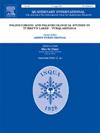Late Holocene morphosedimentary and palaeoenvironmental study of the Middle Drâa river basin (southeastern Morocco)
IF 1.9
3区 地球科学
Q3 GEOGRAPHY, PHYSICAL
引用次数: 0
Abstract
The alluvial filling of the middle basin of the Drâa River (southeastern Morocco) has recorded hydrogeomorphological responses to environmental changes. A systematic study of the Holocene fluvial terraces along an upstream-downstream section of about a hundred kilometers, combined with a sedimentary multiproxy study, was carried out on the alluvial archives of the Drâa's river. The stratigraphic field studies, combined with granulometric and geochemical X-ray Fluorescence analyses and radiocarbon dating, enable us to propose, for the first time, a reconstruction of the major stages in the morpho-hydrodynamic and paleo-environmental evolution of the middle Drâa river over the past 3500 years. Our results highlight six morpho-hydrodynamic and paleoenvironmental phases. Between 3500–2700 and 1800–1600 cal BP, the Drâa river was highly active, associated with torrential activity, reflecting arid climatic conditions. The lack of sedimentary record observed between 2800 and 2350 cal BP points either to a phase of erosion, or to a minimal and discontinuous activity that left no traces in the studied archives. The periods 2350–1800 (Roman Warm Period) and 1600–550 cal BP (Medieval Climate Anomaly) are characterized by strong fine and more regular alluviation punctuated by episodes of low energy of the Drâa floodplain, sometimes favoring fluviosols development that showed similar characteristics in the three outcrops studied. Finally, from 550 cal BP the fluvial records generally shows signs of anthropization, marked by the formation of anthrosols characteristic of fluvial oasis construction, and associated with the presence of ceramics and hearths, in which eolization features are frequent. The comparison of Drâa evolution in a broader paleohydrological and climatic context, integrating other Moroccan studies and regional data, shows solid connection with the river, lakes, and marine archives from the southern Mediterranean to the Western Sahelian steppe zones, revealing a clear response of this large hydrosystem to regional climatic variations.
德拉河中游流域(摩洛哥东南部)全新世晚期形态沉积和古环境研究
德拉河(摩洛哥东南部)中游流域的冲积层记录了水文地质对环境变化的反应。对德拉河冲积层档案进行了系统研究,对上游至下游约一百公里的全新世河川阶地进行了系统研究,并进行了沉积多代研究。通过地层实地研究,结合粒度分析和地球化学 X 射线荧光分析以及放射性碳年代测定,我们首次提出了重建 Drâa 河中游过去 3500 年形态-水动力和古环境演变的主要阶段。我们的研究结果强调了六个形态-水动力和古环境阶段。在公元前 3500-2700 年和公元前 1800-1600 年之间,德拉河水流高度活跃,伴随着暴雨活动,反映了干旱的气候条件。公元前 2800 年至 2350 年期间缺乏沉积物记录,这表明当时处于侵蚀阶段,或者说当时的活动极少且不连续,在所研究的档案中没有留下任何痕迹。公元前 2350 至 1800 年(罗马温暖时期)和公元前 1600 至 550 年(中世纪气候异常时期)的特点是冲积强烈且更有规律,其间德拉洪泛区的能量较低,有时有利于淤积土的形成,这在所研究的三个露头中表现出相似的特征。最后,从公元前 550 年开始,河道记录普遍显示出人类化的迹象,其标志是形成了河道绿洲建设所特有的人类溶胶,并与陶瓷和炉灶的存在相关联,其中经常出现沉积特征。结合其他摩洛哥研究和地区数据,在更广泛的古水文和气候背景下对德拉雅的演变进行比较,显示出与从地中海南部到西萨赫勒草原区的河流、湖泊和海洋档案的紧密联系,揭示了这一大型水系对地区气候变异的明显反应。
本文章由计算机程序翻译,如有差异,请以英文原文为准。
求助全文
约1分钟内获得全文
求助全文
来源期刊

Quaternary International
地学-地球科学综合
CiteScore
5.60
自引率
4.50%
发文量
336
审稿时长
3 months
期刊介绍:
Quaternary International is the official journal of the International Union for Quaternary Research. The objectives are to publish a high quality scientific journal under the auspices of the premier Quaternary association that reflects the interdisciplinary nature of INQUA and records recent advances in Quaternary science that appeal to a wide audience.
This series will encompass all the full spectrum of the physical and natural sciences that are commonly employed in solving Quaternary problems. The policy is to publish peer refereed collected research papers from symposia, workshops and meetings sponsored by INQUA. In addition, other organizations may request publication of their collected works pertaining to the Quaternary.
 求助内容:
求助内容: 应助结果提醒方式:
应助结果提醒方式:


